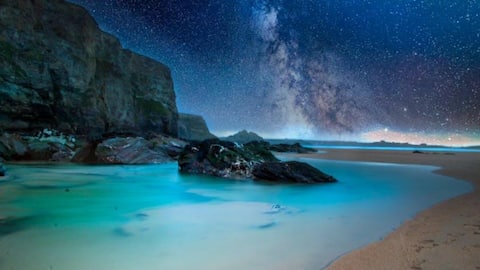Exploring Maldives' enchanting Sea of Stars
What's the story
The Maldives, an archipelago of 26 atolls nestled in the Indian Ocean, is renowned for its pristine beaches. However, one of its most captivating phenomena is the "Sea of Stars", a natural spectacle that illuminates the shores with a mesmerizing glow at night. This ethereal phenomenon has captured the imagination of travelers worldwide, drawing them to witness the magical spectacle firsthand.
Phenomenon
Bioluminescence
The Sea of Stars phenomenon is caused by bioluminescent phytoplankton, particularly dinoflagellates. These tiny organisms emit light when disturbed, resulting in a mesmerizing blue glow that resembles stars on the ocean's surface. This bioluminescence serves as a defense mechanism, wards off predators and lures prey. When agitated, the dinoflagellates emit a radiant blue light, enchanting observers with a dazzling natural spectacle.
Place to witness
Vaadhoo Island
Vaadhoo Island, situated within the picturesque Raa Atoll of the Maldives, emerges as an haven for encountering the mesmerizing Sea of Stars spectacle. Here, under the darkened sky, bioluminescent phytoplankton illuminate the tranquil waters, creating a breathtaking display similar to stars scattered across the ocean's surface. Visitors to the island witness nature's own light show creating an unforgettable and magical experience.
Optimal time
When does this happen?
The optimal time to witness the Sea of Stars phenomenon on Vaadhoo Island in the Maldives spans over the months of April through November. During this timeframe, warmer water temperatures and an augmented plankton population heighten the likelihood of experiencing an awe-inspiring light display. However, it's important to note that the occurrence of the Sea of Stars cannot be precisely foretold.
Various places
Global Bioluminescent Wonders
Although bioluminescent phenomena are prominent in the beaches of the Maldives, they aren't exclusive to certain places. These captivating displays can be encountered globally wherever plankton exists, even in unexpected places. In Southeast Asia, destinations such as Thailand boast sightings of these enchanting organisms along the Gulf of Thailand. Similarly, Australia's coastline offers opportunities to witness bioluminescent displays.
Red light
Precautions
To enhance the observation of bioluminescent organisms while minimizing disruption to their natural behavior, it's advisable to utilize red light sources for illumination when necessary. Unlike white light, red light disturbs these organisms less, allowing for better observation without causing undue stress. By employing red light, observers can enjoy the spectacle of the Sea of Stars while minimizing their impact on the delicate ecosystem.
Distance
Avoid disturbing water
Furthermore, it's crucial to exercise restraint and avoid disturbing the water unnecessarily. While it may be tempting to touch or stir water to witness bioluminescence up close, such actions can harm organisms and disrupt their fragile ecosystem. Instead, observers should maintain a respectful distance and refrain from excessive splashing or stirring of the water.
